[English] 日本語
 Yorodumi
Yorodumi- PDB-5no4: RsgA-GDPNP bound to the 30S ribosomal subunit (RsgA assembly inte... -
+ Open data
Open data
- Basic information
Basic information
| Entry | Database: PDB / ID: 5no4 | ||||||
|---|---|---|---|---|---|---|---|
| Title | RsgA-GDPNP bound to the 30S ribosomal subunit (RsgA assembly intermediate with uS3) | ||||||
 Components Components |
| ||||||
 Keywords Keywords |  RIBOSOME RIBOSOME | ||||||
| Function / homology |  Function and homology information Function and homology information guanosine tetraphosphate binding / mRNA base-pairing translational repressor activity / ornithine decarboxylase inhibitor activity / guanosine tetraphosphate binding / mRNA base-pairing translational repressor activity / ornithine decarboxylase inhibitor activity /  Hydrolases; Acting on acid anhydrides; In phosphorus-containing anhydrides / misfolded RNA binding / transcription antitermination factor activity, RNA binding / Group I intron splicing / RNA folding / four-way junction DNA binding / negative regulation of translational initiation ... Hydrolases; Acting on acid anhydrides; In phosphorus-containing anhydrides / misfolded RNA binding / transcription antitermination factor activity, RNA binding / Group I intron splicing / RNA folding / four-way junction DNA binding / negative regulation of translational initiation ... guanosine tetraphosphate binding / mRNA base-pairing translational repressor activity / ornithine decarboxylase inhibitor activity / guanosine tetraphosphate binding / mRNA base-pairing translational repressor activity / ornithine decarboxylase inhibitor activity /  Hydrolases; Acting on acid anhydrides; In phosphorus-containing anhydrides / misfolded RNA binding / transcription antitermination factor activity, RNA binding / Group I intron splicing / RNA folding / four-way junction DNA binding / negative regulation of translational initiation / regulation of mRNA stability / mRNA regulatory element binding translation repressor activity / transcription elongation factor complex / positive regulation of RNA splicing / DNA endonuclease activity / regulation of DNA-templated transcription elongation / transcription antitermination / maintenance of translational fidelity / DNA-templated transcription termination / mRNA 5'-UTR binding / Hydrolases; Acting on acid anhydrides; In phosphorus-containing anhydrides / misfolded RNA binding / transcription antitermination factor activity, RNA binding / Group I intron splicing / RNA folding / four-way junction DNA binding / negative regulation of translational initiation / regulation of mRNA stability / mRNA regulatory element binding translation repressor activity / transcription elongation factor complex / positive regulation of RNA splicing / DNA endonuclease activity / regulation of DNA-templated transcription elongation / transcription antitermination / maintenance of translational fidelity / DNA-templated transcription termination / mRNA 5'-UTR binding /  ribosomal small subunit biogenesis / small ribosomal subunit rRNA binding / ribosomal small subunit biogenesis / small ribosomal subunit rRNA binding /  ribosomal small subunit assembly / GDP binding / cytosolic small ribosomal subunit / ribosomal small subunit assembly / GDP binding / cytosolic small ribosomal subunit /  ribosome biogenesis / ribosome biogenesis /  regulation of translation / small ribosomal subunit / cytoplasmic translation / regulation of translation / small ribosomal subunit / cytoplasmic translation /  tRNA binding / negative regulation of translation / tRNA binding / negative regulation of translation /  rRNA binding / molecular adaptor activity / rRNA binding / molecular adaptor activity /  ribosome / structural constituent of ribosome / ribosome / structural constituent of ribosome /  translation / response to antibiotic / translation / response to antibiotic /  mRNA binding / mRNA binding /  GTPase activity / GTP binding / GTPase activity / GTP binding /  RNA binding / zinc ion binding / RNA binding / zinc ion binding /  membrane / membrane /  metal ion binding / metal ion binding /  cytosol / cytosol /  cytoplasm cytoplasmSimilarity search - Function | ||||||
| Biological species |   Escherichia coli (E. coli) Escherichia coli (E. coli) | ||||||
| Method |  ELECTRON MICROSCOPY / ELECTRON MICROSCOPY /  single particle reconstruction / single particle reconstruction /  cryo EM / Resolution: 5.16 Å cryo EM / Resolution: 5.16 Å | ||||||
 Authors Authors | Lopez-Alonso, J.P. / Kaminishi, T. / Kikuchi, T. / Hirata, Y. / Iturrioz, I. / Dhimole, N. / Schedlbauer, A. / Hase, Y. / Goto, S. / Kurita, D. ...Lopez-Alonso, J.P. / Kaminishi, T. / Kikuchi, T. / Hirata, Y. / Iturrioz, I. / Dhimole, N. / Schedlbauer, A. / Hase, Y. / Goto, S. / Kurita, D. / Muto, A. / Zhou, S. / Naoe, C. / Mills, D.J. / Gil-Carton, D. / Takemoto, C. / Himeno, H. / Fucini, P. / Connell, S.R. | ||||||
 Citation Citation |  Journal: Nucleic Acids Res / Year: 2017 Journal: Nucleic Acids Res / Year: 2017Title: RsgA couples the maturation state of the 30S ribosomal decoding center to activation of its GTPase pocket. Authors: Jorge Pedro López-Alonso / Tatsuya Kaminishi / Takeshi Kikuchi / Yuya Hirata / Idoia Iturrioz / Neha Dhimole / Andreas Schedlbauer / Yoichi Hase / Simon Goto / Daisuke Kurita / Akira Muto / ...Authors: Jorge Pedro López-Alonso / Tatsuya Kaminishi / Takeshi Kikuchi / Yuya Hirata / Idoia Iturrioz / Neha Dhimole / Andreas Schedlbauer / Yoichi Hase / Simon Goto / Daisuke Kurita / Akira Muto / Shu Zhou / Chieko Naoe / Deryck J Mills / David Gil-Carton / Chie Takemoto / Hyouta Himeno / Paola Fucini / Sean R Connell /    Abstract: During 30S ribosomal subunit biogenesis, assembly factors are believed to prevent accumulation of misfolded intermediate states of low free energy that slowly convert into mature 30S subunits, ...During 30S ribosomal subunit biogenesis, assembly factors are believed to prevent accumulation of misfolded intermediate states of low free energy that slowly convert into mature 30S subunits, namely, kinetically trapped particles. Among the assembly factors, the circularly permuted GTPase, RsgA, plays a crucial role in the maturation of the 30S decoding center. Here, directed hydroxyl radical probing and single particle cryo-EM are employed to elucidate RsgA΄s mechanism of action. Our results show that RsgA destabilizes the 30S structure, including late binding r-proteins, providing a structural basis for avoiding kinetically trapped assembly intermediates. Moreover, RsgA exploits its distinct GTPase pocket and specific interactions with the 30S to coordinate GTPase activation with the maturation state of the 30S subunit. This coordination validates the architecture of the decoding center and facilitates the timely release of RsgA to control the progression of 30S biogenesis. | ||||||
| History |
|
- Structure visualization
Structure visualization
| Movie |
 Movie viewer Movie viewer |
|---|---|
| Structure viewer | Molecule:  Molmil Molmil Jmol/JSmol Jmol/JSmol |
- Downloads & links
Downloads & links
- Download
Download
| PDBx/mmCIF format |  5no4.cif.gz 5no4.cif.gz | 1.1 MB | Display |  PDBx/mmCIF format PDBx/mmCIF format |
|---|---|---|---|---|
| PDB format |  pdb5no4.ent.gz pdb5no4.ent.gz | 904 KB | Display |  PDB format PDB format |
| PDBx/mmJSON format |  5no4.json.gz 5no4.json.gz | Tree view |  PDBx/mmJSON format PDBx/mmJSON format | |
| Others |  Other downloads Other downloads |
-Validation report
| Arichive directory |  https://data.pdbj.org/pub/pdb/validation_reports/no/5no4 https://data.pdbj.org/pub/pdb/validation_reports/no/5no4 ftp://data.pdbj.org/pub/pdb/validation_reports/no/5no4 ftp://data.pdbj.org/pub/pdb/validation_reports/no/5no4 | HTTPS FTP |
|---|
-Related structure data
| Related structure data |  3663MC  3661C  3662C  5no2C  5no3C M: map data used to model this data C: citing same article ( |
|---|---|
| Similar structure data |
- Links
Links
- Assembly
Assembly
| Deposited unit | 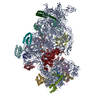
|
|---|---|
| 1 |
|
- Components
Components
-30S ribosomal protein ... , 18 types, 18 molecules CDEFGHIJKLMNOPQRST
| #2: Protein |  / Small ribosomal subunit protein uS3 / Small ribosomal subunit protein uS3Mass: 23078.785 Da / Num. of mol.: 1 / Source method: isolated from a natural source / Source: (natural)   Escherichia coli (strain K12) (bacteria) / References: UniProt: P0A7V3 Escherichia coli (strain K12) (bacteria) / References: UniProt: P0A7V3 |
|---|---|
| #3: Protein |  / Small ribosomal subunit protein uS4 / Small ribosomal subunit protein uS4Mass: 23383.002 Da / Num. of mol.: 1 / Source method: isolated from a natural source / Source: (natural)   Escherichia coli (strain K12) (bacteria) / References: UniProt: P0A7V8 Escherichia coli (strain K12) (bacteria) / References: UniProt: P0A7V8 |
| #4: Protein |  / Small ribosomal subunit protein uS5 / Small ribosomal subunit protein uS5Mass: 16361.878 Da / Num. of mol.: 1 / Source method: isolated from a natural source / Source: (natural)   Escherichia coli (strain K12) (bacteria) / References: UniProt: P0A7W1 Escherichia coli (strain K12) (bacteria) / References: UniProt: P0A7W1 |
| #5: Protein |  / Small ribosomal subunit protein bS6 / Small ribosomal subunit protein bS6Mass: 12326.251 Da / Num. of mol.: 1 / Source method: isolated from a natural source / Source: (natural)   Escherichia coli (strain K12) (bacteria) / References: UniProt: P02358 Escherichia coli (strain K12) (bacteria) / References: UniProt: P02358 |
| #6: Protein |  / Small ribosomal subunit protein uS7 / Small ribosomal subunit protein uS7Mass: 14543.850 Da / Num. of mol.: 1 / Source method: isolated from a natural source / Source: (natural)   Escherichia coli (strain K12) (bacteria) / References: UniProt: P02359 Escherichia coli (strain K12) (bacteria) / References: UniProt: P02359 |
| #7: Protein |  / Small ribosomal subunit protein uS8 / Small ribosomal subunit protein uS8Mass: 14015.361 Da / Num. of mol.: 1 / Source method: isolated from a natural source / Source: (natural)   Escherichia coli (strain K12) (bacteria) / References: UniProt: P0A7W7 Escherichia coli (strain K12) (bacteria) / References: UniProt: P0A7W7 |
| #8: Protein |  / Small ribosomal subunit protein uS9 / Small ribosomal subunit protein uS9Mass: 14554.882 Da / Num. of mol.: 1 / Source method: isolated from a natural source / Source: (natural)   Escherichia coli (strain K12) (bacteria) / References: UniProt: P0A7X3 Escherichia coli (strain K12) (bacteria) / References: UniProt: P0A7X3 |
| #9: Protein |  / Small ribosomal subunit protein uS10 / Small ribosomal subunit protein uS10Mass: 11325.117 Da / Num. of mol.: 1 / Source method: isolated from a natural source / Source: (natural)   Escherichia coli (strain K12) (bacteria) / References: UniProt: P0A7R5 Escherichia coli (strain K12) (bacteria) / References: UniProt: P0A7R5 |
| #10: Protein |  / Small ribosomal subunit protein uS11 / Small ribosomal subunit protein uS11Mass: 12487.200 Da / Num. of mol.: 1 / Source method: isolated from a natural source / Source: (natural)   Escherichia coli (strain K12) (bacteria) / References: UniProt: P0A7R9 Escherichia coli (strain K12) (bacteria) / References: UniProt: P0A7R9 |
| #11: Protein/peptide |  / Small ribosomal subunit protein uS12 / Small ribosomal subunit protein uS12Mass: 1641.981 Da / Num. of mol.: 1 / Source method: isolated from a natural source / Source: (natural)   Escherichia coli (strain K12) (bacteria) / References: UniProt: P0A7S3 Escherichia coli (strain K12) (bacteria) / References: UniProt: P0A7S3 |
| #12: Protein |  / Small ribosomal subunit protein uS13 / Small ribosomal subunit protein uS13Mass: 12625.753 Da / Num. of mol.: 1 / Source method: isolated from a natural source / Source: (natural)   Escherichia coli (strain K12) (bacteria) / References: UniProt: P0A7S9 Escherichia coli (strain K12) (bacteria) / References: UniProt: P0A7S9 |
| #13: Protein |  / Small ribosomal subunit protein uS14 / Small ribosomal subunit protein uS14Mass: 11475.364 Da / Num. of mol.: 1 / Source method: isolated from a natural source / Source: (natural)   Escherichia coli (strain K12) (bacteria) / References: UniProt: P0AG59 Escherichia coli (strain K12) (bacteria) / References: UniProt: P0AG59 |
| #14: Protein |  / Small ribosomal subunit protein uS15 / Small ribosomal subunit protein uS15Mass: 10159.621 Da / Num. of mol.: 1 / Source method: isolated from a natural source / Source: (natural)   Escherichia coli (strain K12) (bacteria) / References: UniProt: P0ADZ4 Escherichia coli (strain K12) (bacteria) / References: UniProt: P0ADZ4 |
| #15: Protein |  / Small ribosomal subunit protein bS16 / Small ribosomal subunit protein bS16Mass: 9207.572 Da / Num. of mol.: 1 / Source method: isolated from a natural source / Source: (natural)   Escherichia coli (strain K12) (bacteria) / References: UniProt: P0A7T3 Escherichia coli (strain K12) (bacteria) / References: UniProt: P0A7T3 |
| #16: Protein |  / Small ribosomal subunit protein uS17 / Small ribosomal subunit protein uS17Mass: 9263.946 Da / Num. of mol.: 1 / Source method: isolated from a natural source / Source: (natural)   Escherichia coli (strain K12) (bacteria) / References: UniProt: P0AG63 Escherichia coli (strain K12) (bacteria) / References: UniProt: P0AG63 |
| #17: Protein |  / Small ribosomal subunit protein bS18 / Small ribosomal subunit protein bS18Mass: 6466.477 Da / Num. of mol.: 1 / Source method: isolated from a natural source / Source: (natural)   Escherichia coli (strain K12) (bacteria) / References: UniProt: P0A7T7 Escherichia coli (strain K12) (bacteria) / References: UniProt: P0A7T7 |
| #18: Protein |  / Small ribosomal subunit protein uS19 / Small ribosomal subunit protein uS19Mass: 9057.626 Da / Num. of mol.: 1 / Source method: isolated from a natural source / Source: (natural)   Escherichia coli (strain K12) (bacteria) / References: UniProt: P0A7U3 Escherichia coli (strain K12) (bacteria) / References: UniProt: P0A7U3 |
| #19: Protein |  / Small ribosomal subunit protein bS20 / Small ribosomal subunit protein bS20Mass: 9577.268 Da / Num. of mol.: 1 / Source method: isolated from a natural source / Source: (natural)   Escherichia coli (strain K12) (bacteria) / References: UniProt: P0A7U7 Escherichia coli (strain K12) (bacteria) / References: UniProt: P0A7U7 |
-RNA chain / Protein , 2 types, 2 molecules AZ
| #1: RNA chain |  Mass: 497404.969 Da / Num. of mol.: 1 / Source method: isolated from a natural source / Source: (natural)   Escherichia coli (strain K12) (bacteria) / References: Escherichia coli (strain K12) (bacteria) / References:  GenBank: 1108570162 GenBank: 1108570162 |
|---|---|
| #20: Protein | Mass: 34850.457 Da / Num. of mol.: 1 Source method: isolated from a genetically manipulated source Source: (gene. exp.)   Escherichia coli (strain K12) (bacteria) Escherichia coli (strain K12) (bacteria)Gene: rsgA, engC, yjeQ, b4161, JW4122 / Plasmid: p7XNH3 / Production host:   Escherichia coli (E. coli) / Strain (production host): BL21(DE3) Escherichia coli (E. coli) / Strain (production host): BL21(DE3)References: UniProt: P39286,  Hydrolases; Acting on acid anhydrides; In phosphorus-containing anhydrides Hydrolases; Acting on acid anhydrides; In phosphorus-containing anhydrides |
-Non-polymers , 3 types, 73 molecules 

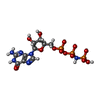


| #21: Chemical | ChemComp-MG / #22: Chemical | ChemComp-ZN / | #23: Chemical | ChemComp-GNP / |  5'-Guanylyl imidodiphosphate 5'-Guanylyl imidodiphosphate |
|---|
-Experimental details
-Experiment
| Experiment | Method:  ELECTRON MICROSCOPY ELECTRON MICROSCOPY |
|---|---|
| EM experiment | Aggregation state: PARTICLE / 3D reconstruction method:  single particle reconstruction single particle reconstruction |
- Sample preparation
Sample preparation
| Component | Name: 30S ribosomal subunit bound by RsgA / Type: RIBOSOME / Entity ID: #1-#20 / Source: MULTIPLE SOURCES / Type: RIBOSOME / Entity ID: #1-#20 / Source: MULTIPLE SOURCES | |||||||||||||||||||||||||
|---|---|---|---|---|---|---|---|---|---|---|---|---|---|---|---|---|---|---|---|---|---|---|---|---|---|---|
| Molecular weight | Experimental value: NO | |||||||||||||||||||||||||
| Source (natural) | Organism:   Escherichia coli (E. coli) Escherichia coli (E. coli) | |||||||||||||||||||||||||
| Buffer solution | pH: 7.8 | |||||||||||||||||||||||||
| Buffer component |
| |||||||||||||||||||||||||
| Specimen | Embedding applied: NO / Shadowing applied: NO / Staining applied : NO / Vitrification applied : NO / Vitrification applied : YES : YES | |||||||||||||||||||||||||
| Specimen support | Grid material: COPPER / Grid mesh size: 200 divisions/in. / Grid type: Quantifoil R2/1 | |||||||||||||||||||||||||
Vitrification | Instrument: FEI VITROBOT MARK II / Cryogen name: ETHANE / Humidity: 95 % / Chamber temperature: 278 K |
- Electron microscopy imaging
Electron microscopy imaging
| Experimental equipment |  Model: Titan Krios / Image courtesy: FEI Company |
|---|---|
| Microscopy | Model: FEI TITAN KRIOS |
| Electron gun | Electron source : :  FIELD EMISSION GUN / Accelerating voltage: 300 kV / Illumination mode: SPOT SCAN FIELD EMISSION GUN / Accelerating voltage: 300 kV / Illumination mode: SPOT SCAN |
| Electron lens | Mode: BRIGHT FIELD Bright-field microscopy / Nominal magnification: 59000 X / Calibrated magnification: 101000 X / Nominal defocus max: 3000 nm / Nominal defocus min: 1000 nm / Cs Bright-field microscopy / Nominal magnification: 59000 X / Calibrated magnification: 101000 X / Nominal defocus max: 3000 nm / Nominal defocus min: 1000 nm / Cs : 2.7 mm : 2.7 mm |
| Specimen holder | Cryogen: NITROGEN |
| Image recording | Average exposure time: 1.5 sec. / Electron dose: 2.3 e/Å2 / Detector mode: INTEGRATING / Film or detector model: FEI FALCON II (4k x 4k) / Num. of real images: 3408 |
| Image scans | Width: 2048 / Height: 2048 / Movie frames/image: 13 |
- Processing
Processing
| Software | Name: PHENIX / Classification: refinement | |||||||||||||||||||||||||||||||||||||||||||||||||||||||
|---|---|---|---|---|---|---|---|---|---|---|---|---|---|---|---|---|---|---|---|---|---|---|---|---|---|---|---|---|---|---|---|---|---|---|---|---|---|---|---|---|---|---|---|---|---|---|---|---|---|---|---|---|---|---|---|---|
| EM software |
| |||||||||||||||||||||||||||||||||||||||||||||||||||||||
CTF correction | Type: PHASE FLIPPING AND AMPLITUDE CORRECTION | |||||||||||||||||||||||||||||||||||||||||||||||||||||||
| Particle selection | Num. of particles selected: 878976 | |||||||||||||||||||||||||||||||||||||||||||||||||||||||
3D reconstruction | Resolution: 5.16 Å / Resolution method: FSC 0.143 CUT-OFF / Num. of particles: 61908 / Symmetry type: POINT | |||||||||||||||||||||||||||||||||||||||||||||||||||||||
| Atomic model building | Protocol: BACKBONE TRACE | |||||||||||||||||||||||||||||||||||||||||||||||||||||||
| Displacement parameters | Biso max: 486.13 Å2 / Biso mean: 227.5331 Å2 / Biso min: 2.8 Å2 | |||||||||||||||||||||||||||||||||||||||||||||||||||||||
| Refine LS restraints |
|
 Movie
Movie Controller
Controller


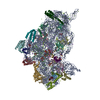
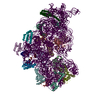
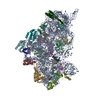


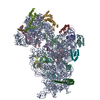
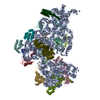
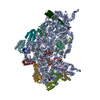
 PDBj
PDBj

































